

Primary Teachers. Resources: Australian Curriculum Digital Technologies. The Digital Technologies curriculum exists within the Technologies learning area of the Australian Curriculum.
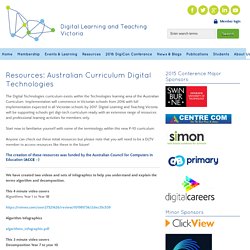
Implementation will commence in Victorian schools from 2016 with full implementation expected in all Victorian schools by 2017. Digital Learning and Teaching Victoria will be supporting schools get digi-tech curriculum ready with an extensive range of resources and professional learning activities for members only. Start now to familiarise yourself with some of the terminology within this new P-10 curriculum. Anyone can check out these initial resources but please note that you will need to be a DLTV member to access resources like these in the future! The creation of these resources was funded by the Australian Council for Computers in Education (ACCE) We have created two videos and sets of infographics to help you understand and explain the terms algorithm and decomposition.
Hello Ruby: Coding For Kids: PreK - Grade 2 story book that teaches computer science (Coding Palz Children's book 1) - Kindle edition by Ayesha. Children Kindle eBooks @ Amazon.com. Computer Science Unplugged. Hopscotch: Coding for kids, a visual programming language. CSUnplugged OS 2015 v3.1. Teaching London Computing: A RESOURCE HUB from CAS LONDON. Teaching London Computing in conjunction with cs4fn have produced a series of fun, mainly unplugged, activities for use in the classroom, suitable for all ages.
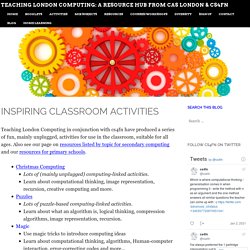
Also see our page on resources listed by topic for secondary computing and our resources for primary schools. More of our resources, including linked computing ‘story’ booklets can be found in our resources section. You may also want to look at cs4fn’s teacher resources or browse the latest cs4fn magazine. Other excellent sources of a similar style of activity are the New Zealand based but globally used CS Unplugged site and the Glasgow University CS Inside project.
CS Fundamentals Unplugged Lessons. Each of these activities can either be used alone or with other computer science lessons on related concepts. The Book - Computer Science Unplugged. All the English-language CS Unplugged activities are available in book form as a free download.
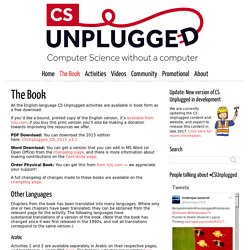
If you’d like a bound, printed copy of the English version, it’s available from lulu.com; if you buy this print version you’ll also be making a donation towards improving the resources we offer. PDF Download: You can download the 2015 edition here: CSUnplugged_OS_2015_v3.1 Word Download: You can get a version that you can edit in MS Word (or Open Office) from the changelog page, and there is more information about making contributions on the Contribute page. Dr. Scratch. Dr. Scratch. Scratch - About. Who Uses Scratch? Scratch is designed especially for ages 8 to 16, but is used by people of all ages. Millions of people are creating Scratch projects in a wide variety of settings, including homes, schools, museums, libraries, and community centers.Learn to Code, Code to LearnThe ability to code computer programs is an important part of literacy in today’s society.
When people learn to code in Scratch, they learn important strategies for solving problems, designing projects, and communicating ideas.Around the World Scratch is used in more than 150 different countries and available in more than 40 languages. To change languages, click the menu at the bottom of the page. Or, in the Project Editor, click the globe at the top of the page. Scratch - Educators. Craft Custom Spells. CodeSpells Trailer. Craft Custom Spells. How to teach coding and programming. From playing about with animations to designing computer games, teaching coding in schools lends itself to plenty of fun learning activities.
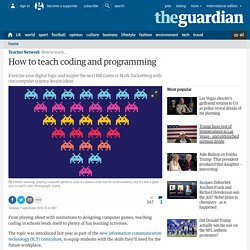
The topic was introduced last year as part of the new information communication technology (ICT) curriculum, to equip students with the skills they’ll need for the future workplace. So this week on the Guardian Teacher Network we’ve been exercising our digital logic to bring together a selection of ideas and resources about teaching computer programming and coding. Primary schools A great starting place for anyone unfamiliar with the new computing curriculum is the Computing at School (CAS) QuickStart Computing website, which features continued professional development (CPD) materials designed to help primary and secondary teachers deliver the new curriculum. About Us - Girls Who Code. When I started Girls Who Code, I never would have imagined that we would grow to become a movement reaching almost 90,000 girls of all backgrounds in all 50 states.

And now, just six years into our work, we’ve reached a tipping point. We are on track to achieve gender parity in computer science by 2027. And we know why: because our work is as much about quantity, as it is about quality. Computer Coding Games for Kids, Carol Vorderman. Bookdepository. Hello Ruby. 8 free tools that teach kids how to code. Hopscotch: Learn to Code Through Creativity on the App Store. Alice.org. Alice is an innovative 3D programming environment that makes it easy to create an animation for telling a story, playing an interactive game, or a video to share on the web.

Alice is a freely available teaching tool designed to be a student's first exposure to object-oriented programming. It allows students to learn fundamental programming concepts in the context of creating animated movies and simple video games. In Alice, 3-D objects (e.g., people, animals, and vehicles) populate a virtual world and students create a program to animate the objects.
In Alice's interactive interface, students drag and drop graphic tiles to create a program, where the instructions correspond to standard statements in a production oriented programming language, such as Java, C++, and C#. Alice allows students to immediately see how their animation programs run, enabling them to easily understand the relationship between the programming statements and the behavior of objects in their animation. Kidsruby.com. About Us - Girls Who Code. Coding for Kids: Free Websites That Teach Kids Programming. As technology dominates our lives, learning basic computer programming isn't just a smart idea, it's an essential skill for grown-ups and children alike.
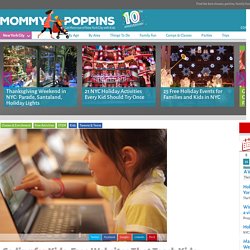
Learning how to build simple websites and games helps kids refine their design, logic and problem-solving abilities. It also allows them to express ideas and creativity in unique ways. Scratch - For Parents. What is the age range for Scratch?

While Scratch is primarily designed for 8 to 16 year olds, it is also used by people of all ages, including younger children with their parents. What resources are available for learning Scratch? If you’re just getting started, there’s a step-by-step guide available inside Scratch, or you can download the Getting Started guide (PDF). The Scratch Cards provide a fun way to learn more. Made with Code. Code Monster from Crunchzilla. <h2>Code Monster gets kids excited about programming.
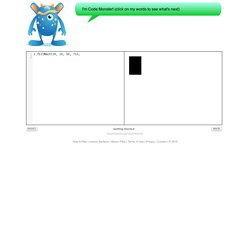
It is a combination of a game and tutorial where kids experiment with learning to code. 8 Educational Sites for Kids Interested in Technology. There are so many educational sites for kids on the web, which can make learning easier, more interactive and, most importantly, more fun for your child.

But what about children interested in technology? Actually, there are plenty of websites designed for the tech-savvy kid, and we’ve put together a list of the very best just for you. If your child is interested in computers, gaming, robots or any other type of technology, these 8 educational sites for kids can help: Brain POP. 20 great books to hook kids and teens on robotics. Kids love robots! And they love reading too. Ranging from preschool to teen, this selection of books includes fiction and nonfiction, activity books and maker manuals, all to help inspire the kids in your life to get into robotics. 2-5 years “On the ground and in the air, Robots, robots everywhere!
. . .